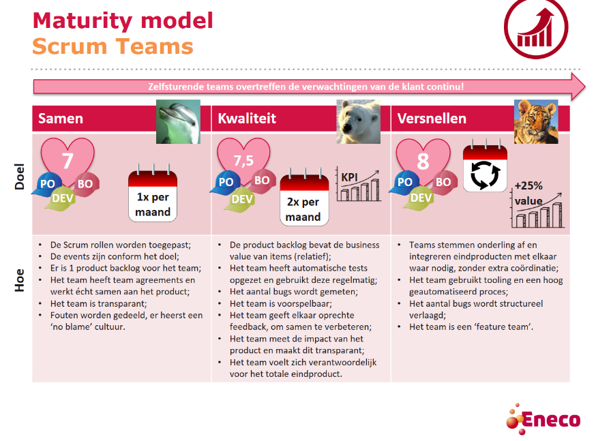
Can you give an example of an ownership model?
Let's unleash the energy
Eneco
Eneco is an energy company. They exist for decades and have a software development department for their internal IT, the websites, the app, CRM and all kind of other products.
They wanted to move to a more agile way of working with different very good reasons. Among:
- Customer focus - the wanted to deliver more value to the customers. Due to higher competition and increased customer expectations, they also needed to focus more on the customer satisfaction and smoothness,
- Employee engagement - people liked to work for a green and environmental friendly organization. But, nevertheless, the employee satisfaction and engagement could be improved,
- Faster delivery - delivering value and functionality quicker to the customers is even more important
They’ve created a nice Ownership-model (in Dutch) for their software development teams. They have used nice names to define the levels of maturity. They are proud sponsors of the WNF.
When a team is promoted to a next level, they get a nice present. For example a huge Dolphin and tickets to the Dutch Dolfinarium.
They used the names of animals with a nice reason:- Dolphin – the first level is all about working together as a team. Dolphins are great team players and known for saving humans.
- Polar bears – the next level is about quality. Test automation and working with CICD. Polar bears are known for the robustness and resilience.
- Cheetah – the third level is all about agility, speed of change. Teams that reach this level can quickly adapt to new market changes.
- existing culture,
- the urgency to grow,
- the competitors and
- the speed-of-change in the market.
But to create an Ownership-model it’s often handy to have a few examples and build from that.
How does the different levels look like?

Levels in the Ownership-model
Metrics |
1 Dolphin |
2 Polar Bear |
3 Cheetah |
| Happiness | 7 | 7.5 | 8 |
| Reliability | 80% | 80% | 80% |
| Release | Monthly | Twice a month | Daily |
| KVI | n.a. | Known and trace | +25% |
I’ll explain these metrics.
- Happiness – this is the happiness from the PO towards the Dev.Team. The happiness of the most important stakeholder of the PO. And the happiness of the Dev.Team.
- Reliability – this is the percentage of storypoints the team has realized vs. committed during sprint planning.
- Release – this is how often the team can release. Daily means: potential daily. Depending on whether the PO really wants to deploy.
- KVI – this is the Key Value Indicator (part of the toolkit). At Polar Bear level the team has to know and trace this KVI. At Cheetah level they have to exceed their original trend with roughly 25%
When is a team promoted?
A team is promoted simply when they can show their numbers. They have to reach the metrics three sprints in a row. So three sprints in a row higher than a 7 for happiness and at least 80% reliability. One sprint below 7 or below 80% restarts the clock. The promotion-request is evaluated by an agile manager and a few employees. When the ‘promotion’ is granted, a fun and energetic event is organized to celebrate it. With cake, speeches, presents and a lot of laughter.
Can a team be demoted?
No. To grow to the next level often a temporarily dip is seen in the output and happiness. Which is often crucial for growth. Once a team has reached a certain level, they can’t lose it. What to do when the team configuration changes? When a team is split or a lot of team members are changed we come up with a whole new team name, start from scratch and work our way up. This is often far more exciting and rewarding for the team members.




